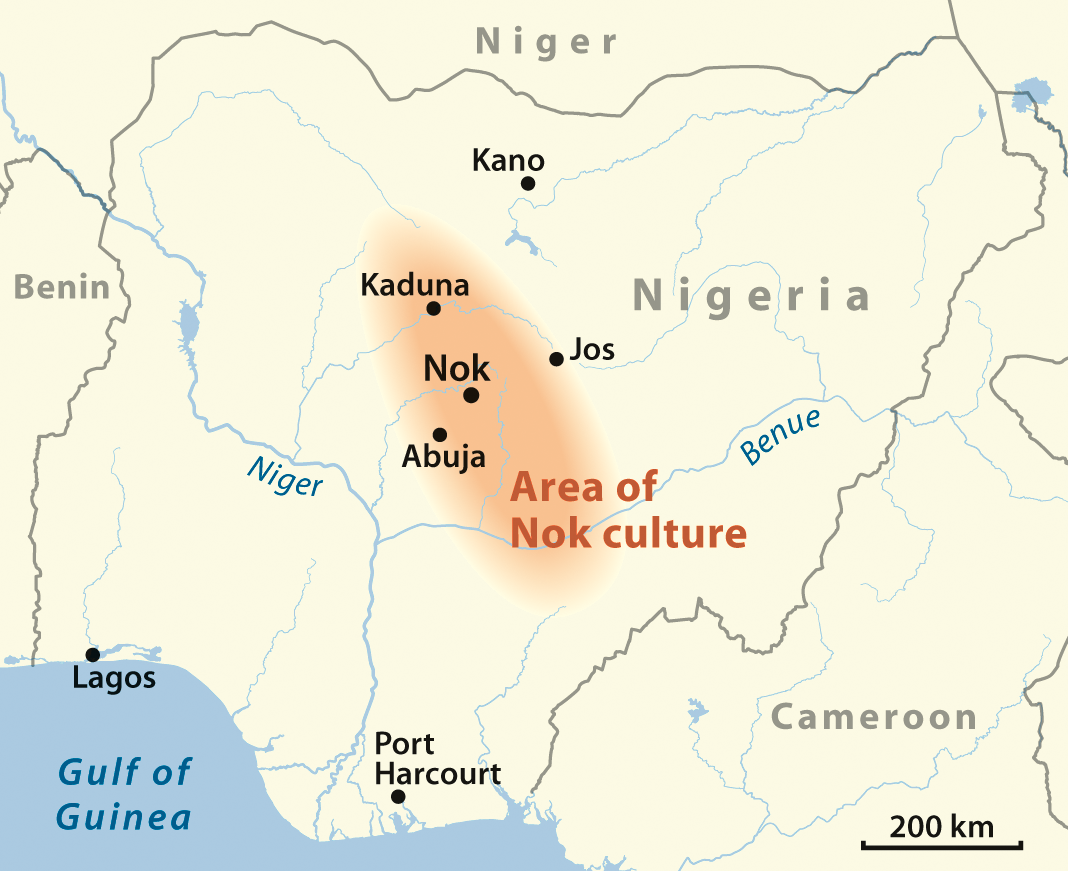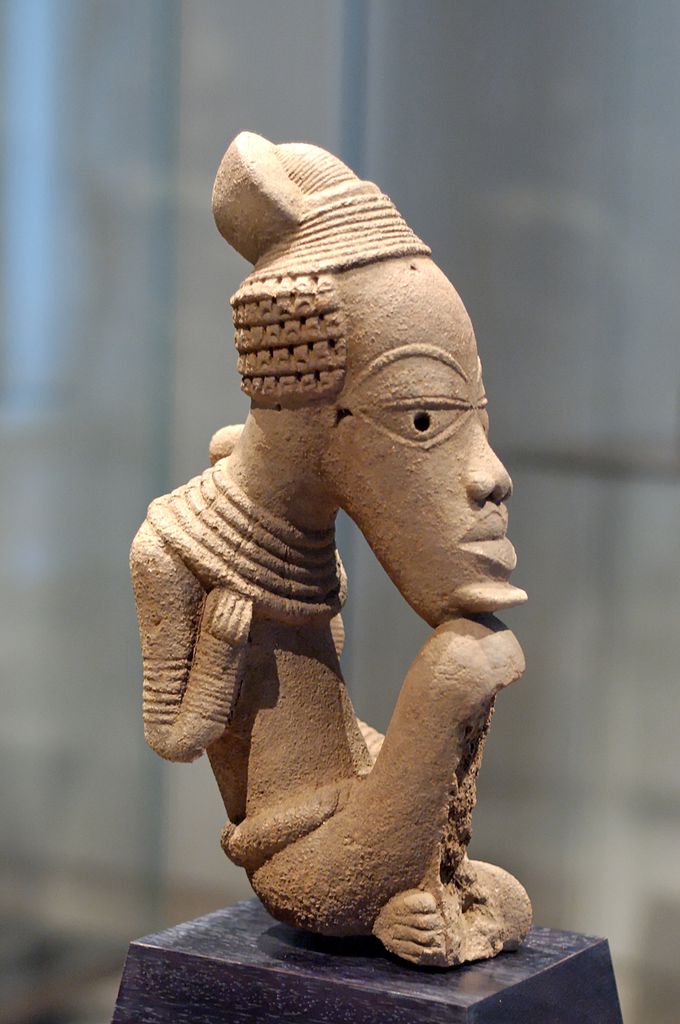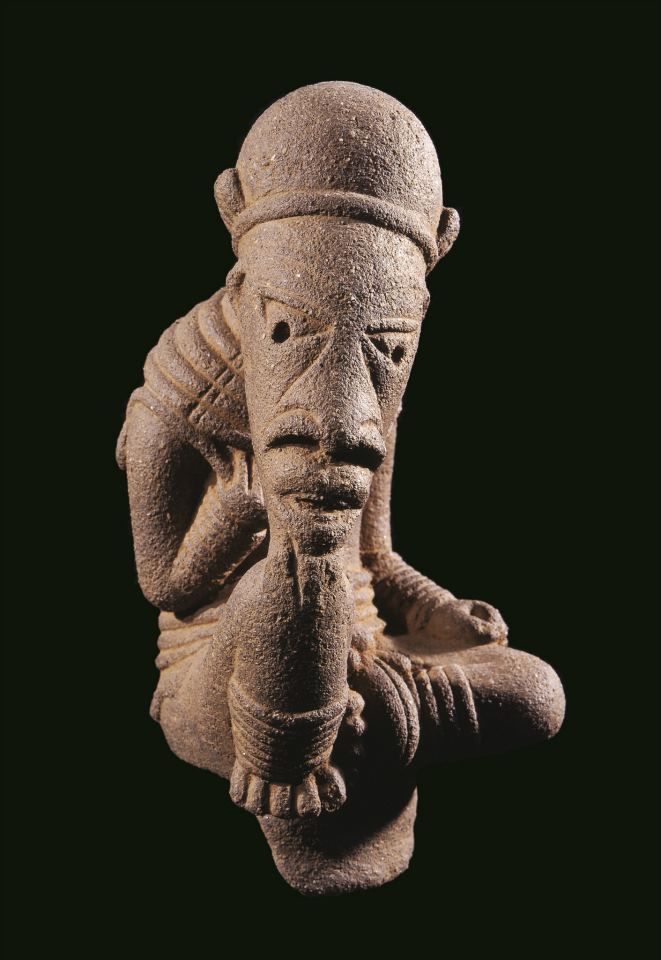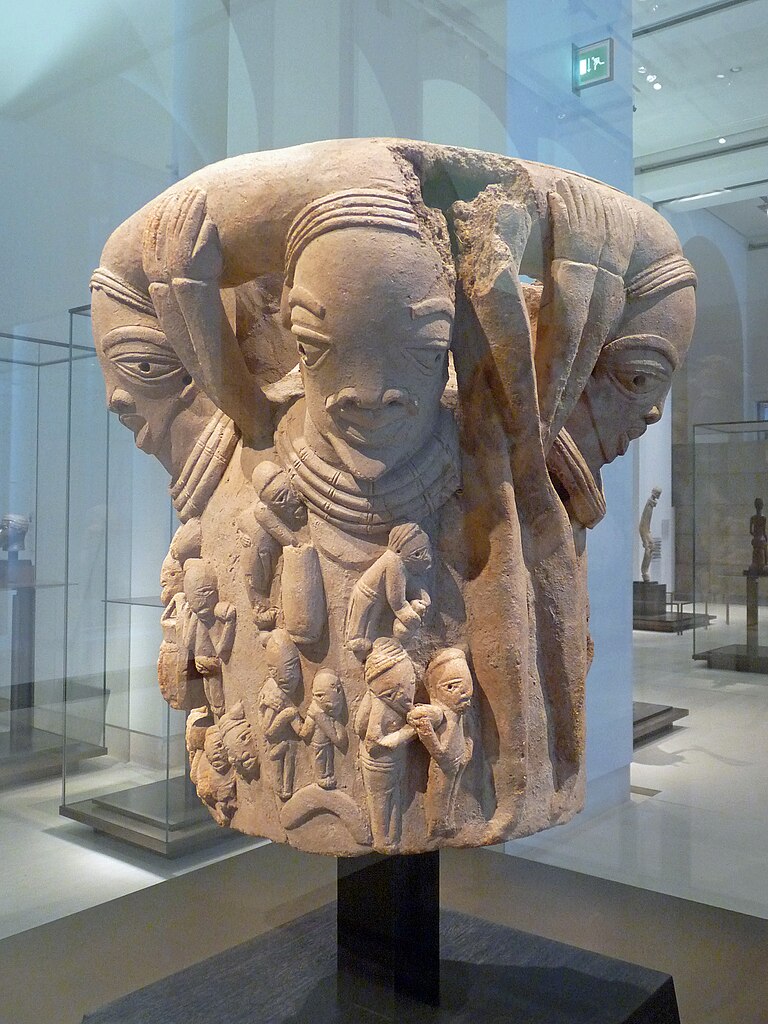The Nok culture
The Nok culture, flourishing in present-day Nigeria from approximately 1000 BCE to 300 CE, is one of the earliest known complex societies in sub-Saharan Africa. Renowned for its distinctive terracotta sculptures and early ironworking, the Nok culture represents a significant chapter in African history. Its cultural and technological achievements influenced later West African civilizations, laying the foundation for complex societies in the region.

Area of the Nok culture (1000 BCE to 300 CE). Source: Wikimedia Commonsꜛ (license: CC BY-SA 3.0)
Origins and early development
The Nok culture arose in the fertile valleys of central Nigeria, benefiting from an environment conducive to agriculture and trade. Archaeological evidence suggests that Nok communities practiced mixed farming, cultivating crops such as millet and sorghum while raising livestock. Their settlement patterns indicate a high degree of organization, with clusters of small villages likely governed by local chieftains or councils.
Ironworking was a hallmark of the Nok culture, making it one of the earliest societies in Africa to produce iron tools and weapons. This technological advancement revolutionized agriculture, hunting, and warfare, giving Nok communities a significant advantage over neighboring groups.
Cultural achievements and art
The Nok culture is best known for its terracotta sculptures, which are among the oldest examples of figurative art in sub-Saharan Africa. These sculptures, often depicting human and animal figures, are characterized by intricate detailing and stylized features such as elongated heads and triangular eyes. The purposes of these sculptures remain debated, with theories ranging from religious and ritualistic uses to symbols of social status or ancestors.



Left: Nok sculpture, terracotta, between 5th c. BCE and 5th c. CE. Source: Wikimedia Commonsꜛ (license: public domain) – Middle: “The thinker” c. 298 CE. Source: Wikimedia Commonsꜛ (license: CC BY-SA 3.0) – Right: For comparison: Pensive Bodhisattva Maitreya, Baekje (today: Korea), late 6th century, gilt bronze. Source: Wikimedia Commonsꜛ (license: CC BY-SA 3.0)
Nok art reflects a sophisticated society with a rich symbolic tradition. The widespread distribution of terracotta artifacts suggests an extensive network of trade and cultural exchange, connecting Nok communities and influencing neighboring regions. Additionally, the quality and consistency of Nok art indicate the presence of specialized artisans supported by a surplus agricultural economy.
Social and economic organization
The Nok culture appears to have been organized around small, autonomous communities with shared cultural and technological practices. The development of iron metallurgy suggests a stratified society with specialized labor roles, including farmers, artisans, and traders. The absence of monumental architecture or centralized political structures distinguishes Nok from contemporary civilizations such as Egypt and Mesopotamia, suggesting a decentralized and egalitarian social system.

Sculpture from the Nok culture, terracotta, 6th century BC - 6th century CE. Source: Wikimedia Commonsꜛ (license: CC BY-SA 3.0)
Trade played a crucial role in Nok society. Evidence of long-distance exchange, including the movement of terracotta artifacts and iron tools, underscores the integration of Nok communities into broader regional networks. These trade connections likely facilitated cultural diffusion, spreading Nok innovations and artistic traditions across West Africa.
Comparisons with Other civilizations
Egypt and Mesopotamia
The Nok culture contrasts with Egypt and Mesopotamia in its lack of urban centers and written records. While Egypt and Mesopotamia developed centralized states and monumental architecture, Nok communities were smaller and less hierarchically organized. However, like these ancient civilizations, the Nok made significant advancements in technology and art, with ironworking paralleling the technological innovations of Mesopotamia’s Bronze Age.
Kingdom of Kush
The Nok culture and the Kingdom of Kush (ca. 1070 BCE–350 CE) share similarities in their use of iron and artistic traditions. Both cultures produced distinctive figurative art, with Nok terracottas and Kushite statues reflecting complex symbolic systems. However, the Kingdom of Kush exhibited greater political centralization and monumental architecture, such as the pyramids of Meroe, distinguishing it from the more decentralized Nok culture.
Other African societies
Within the broader context of Africa, the Nok culture stands out as an early example of ironworking and figurative art. It preceded later West African states, such as the Yoruba and Benin kingdoms, whose artistic traditions were influenced by Nok cultural foundations. Unlike the nomadic pastoralist societies of the Sahara, the Nok were sedentary agriculturalists, emphasizing settled communities and local trade.
Decline and legacy
The decline of the Nok culture around 300 CE remains a subject of scholarly debate. Environmental changes, resource depletion, or the dispersal of populations may have contributed to the disappearance of centralized Nok communities. Despite its decline, the Nok culture left a lasting legacy in West African history. Its innovations in ironworking and art influenced subsequent societies, and its terracotta sculptures continue to be celebrated as masterpieces of African art.
References
- Bernard Fagg, Nok Terracottas, 2000, Ethnographia Books, ISBN: 978-0905788982
- Breunig, P., Nok, African Sculpture in Archaeological Context, 2014, Africa Magna Verlag, ISBN: 9783937248462
- Frank Willett, African Art: An Introduction, 1994, Thames & Hudson, ISBN: 978-0500202678
- Thurstan Shaw, Unearthing Igbo-Ukwu: Archaeological Discoveries in Eastern Nigeria, 1977, Oxford University Press, ISBN: 978-0195752519
- Bassey W. Andah, African Civilizations: Precolonial Cities and States in Tropical Africa, 1987, Cambridge University Press, ISBN: 978-0521266666
- Ekpo Eyo, Two Thousand Years of Nigerian Art, 1977, Ethnographica Ltd, ISBN: 978-0905788036
- Patrick Darling, African Iron Age Archaeology, 1971, Oxford University Press, ISBN: 978-0198131588
- Henry J. Drewal, Yoruba: Nine Centuries of African Art and Thought, 1989, Museum for African Art, ISBN: 978-0945802044
- John G. Jackson, Introduction to African Civilizations, 2015, Martino Fine Books, ISBN: 978-1614278498
- Susan Keech McIntosh, Beyond Chiefdoms: Pathways to Complexity in Africa, 2008, Cambridge University Press, ISBN: 978-0521022699
















comments